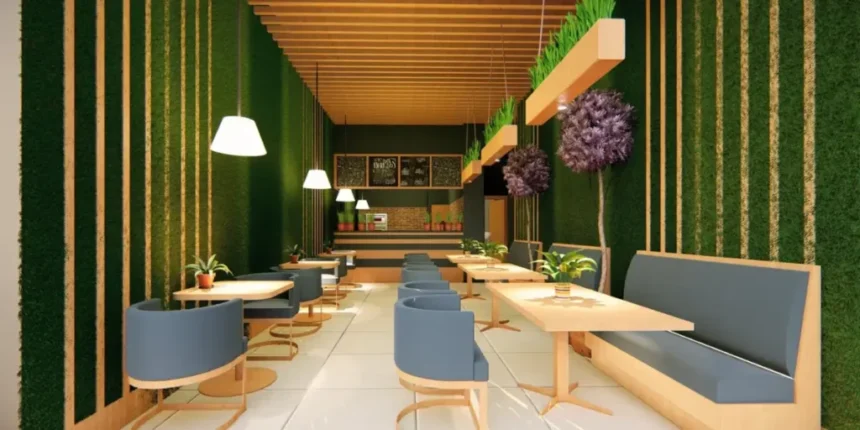In the restaurant industry, creating a positive and lasting impression on customers is key to success. For smaller restaurants, this is even more important, as every inch of space must be carefully optimized to ensure functionality, comfort, and aesthetic appeal. With the right design choices, even the smallest spaces can leave a big impact. In this article, we’ll explore the essential strategies for maximizing a small restaurant space, from layout and storage to bathroom design, ensuring both style and efficiency.
Maximizing Layout and Flow
The foundation of a successful small restaurant is its layout. In compact spaces, creating an efficient and comfortable flow is essential. The design should prioritize ease of movement for both customers and staff, minimizing congestion while maximizing seating capacity. Clever seating arrangements, such as booths or modular tables, can provide flexibility in accommodating different group sizes. By using wall space efficiently and keeping pathways clear, the restaurant will feel more spacious and welcoming, even in a limited area.
To further optimize flow, consider the relationship between the dining area, kitchen, and restroom. An intuitive flow between these areas ensures smoother service and enhances the customer experience. A well-thought-out design minimizes bottlenecks and ensures that staff can move quickly and efficiently between the kitchen, bar, and dining area.
Efficient Use of Storage
Optimizing storage is a primary hurdle in small restaurant design. Given spatial constraints, the key is to effectively store equipment, supplies, and ingredients without hindering the restaurant’s operational flow. Integrated storage options, such as built-in shelving or under-counter cabinets, are ideal for maintaining a neat and organized environment while maximizing valuable floor space.
A clever approach involves incorporating multi-functional furniture and equipment into the design. For instance, tables or benches that serve as storage units, or compact, stackable storage options, can provide essential additional space for tools and supplies without occupying more room. Another useful technique is to ensure that kitchen storage is highly organized, with clear labeling and categorization. This helps minimize time spent searching for ingredients and equipment, making the cooking process much more efficient. Additionally, a solid financial plan can ensure that the costs associated with these storage solutions fit within your overall budget.
Optimizing Restaurant Bathroom Design
While often overlooked, the design of a restaurant’s bathroom plays a key role in customer satisfaction. In small spaces, it’s essential to optimize the bathroom layout, ensuring it remains functional and comfortable. Effective bathroom design is about more than just aesthetics—it’s about ensuring privacy, accessibility, and practicality in a compact area.
Restaurant bathroom dimensions should be carefully planned to ensure adequate space for movement and functionality. A single-occupancy restroom in a small restaurant should ideally be between 36 and 40 square feet. This ensures that the space feels neither cramped nor too sparse. When working with limited space, opting for efficient fixtures and bathroom partitions can maximize the available area without sacrificing comfort. These partitions should be made of durable, easy-to-clean materials, ensuring the restroom remains hygienic and functional even with heavy use.
Choosing the right fixtures is key in a small restroom. Space-saving designs, such as wall-mounted sinks and toilets, can help optimize floor space. Additionally, investing in high-quality, easy-to-clean materials for both flooring and fixtures will simplify maintenance, ensuring the restroom remains fresh and appealing to customers.
Lighting and Ambience
To maximize the impact of a small restaurant, lighting is a key tool for enhancing the atmosphere. Proper lighting can make a compact space feel warm, inviting, and even spacious. The strategic layering of ambient, task, and accent lighting is crucial for both practicality and mood creation.
Ambient lighting should dominate the space, offering warmth and comfort to guests. In addition to traditional overhead lights, consider using softer lighting such as sconces or lamps to create a cozy atmosphere. In smaller restaurants, dimmable lighting fixtures are an excellent choice, allowing you to adjust the mood depending on the time of day or special events. For instance, bright lighting during daytime hours can provide an energetic and lively feel, while softer lighting at night can create a more intimate and romantic atmosphere.
Task lighting is essential in kitchens and service stations, prioritizing functionality. Bright, focused illumination in food preparation zones enables staff to operate both efficiently and safely. In the dining area, accent lighting can draw attention to distinctive decor, artwork, or architectural features, emphasizing the restaurant’s character and contributing to a well-conceived ambiance.
Maximizing natural light in a small restaurant can further enhance its appeal. Large windows or strategically placed mirrors can reflect light, creating a sense of openness. Natural light creates a welcoming atmosphere that feels spacious and can positively influence customer mood.
Creating Style in a Compact Space
A small restaurant doesn’t have to sacrifice style for functionality. Optimizing restaurant design in a small space can have a big impact. A well-designed compact space can be transformed into a stylish and memorable destination. Careful selection of design elements can make it feel both comfortable and sophisticated.
For small restaurants, strategic design is key to maximizing impact. The perception of space can be expanded through the use of light and neutral colors, while a cozy and dynamic atmosphere can be achieved with bold hues and patterns. To enhance spaciousness, prioritize comfort with minimalist furniture and clean lines. Incorporating textures like wood, metal, or stone will add warmth and elegance, creating an inviting and aesthetically pleasing environment.
Decorative elements such as artwork, indoor plants, and strategically placed mirrors can add personality without overwhelming the space. The right décor pieces should feel integrated into the overall design theme, contributing to the ambiance rather than competing with it. One way to create style in small spaces is by incorporating unique lighting fixtures, such as pendant lights or chandeliers, that can serve as focal points.
Balancing Trendy and Timeless
While it’s tempting to incorporate the latest design trends, it’s important to strike a balance between trendy elements and timeless features. This ensures that the restaurant remains relevant and fresh for years to come. Classic furniture pieces, durable finishes, and timeless color schemes can help maintain the restaurant’s appeal, even as trends come and go.
To achieve a lasting, contemporary aesthetic and avoid frequent renovations, a small restaurant can integrate modern trends with classic design elements. The key is to focus on long-lasting features, such as durable materials, well-made furniture, and adaptable lighting, while incorporating trendy accents that can be easily updated.
For example, a traditional design element like wood paneling can be paired with modern, sleek furniture or contemporary lighting fixtures to create an appealing contrast. This blend of old and new will make the restaurant feel timeless while allowing for flexibility in future updates.
Conclusion
Transforming a compact restaurant space into an efficient and inviting environment demands meticulous planning, ingenuity, and a keen eye for detail. Owners can achieve this by optimizing the layout and flow, implementing intelligent storage solutions, and prioritizing functional areas like restrooms and lighting. Deliberate design choices are crucial to maximizing every square inch while preserving comfort and style. Having a solid financial plan is also essential for balancing the cost of design improvements with your budget. With a strategic approach, even the most modest restaurant can leave a significant impression, providing a memorable dining experience that fosters customer loyalty.


